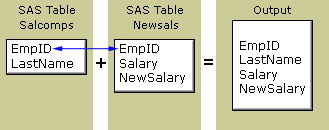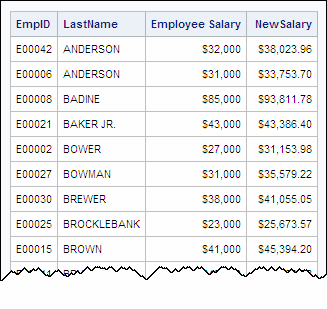Querying Multiple Tables
Overview
This topic deals with the more complex
task of extracting data from two or more tables.
Previously, you learned
how to write a PROC SQL step to query a single table. Suppose you
now want to examine data that is stored in two tables. PROC SQL enables
you to combine tables horizontally, in other words, to combine rows
of data.
In SQL terminology, combining tables horizontally is
called joining tables. Joins do not alter the original tables.
Suppose you want to
create a report that displays the following information for employees
of a company: employee identification number, last name, original
salary, and new salary. There is no single table that contains all
of these columns, so you must join the two tables Sasuser.Salcomps
and Sasuser.Newsals. In your query, you want to select four columns,
two from the first table and two from the second table. You also need
to ensure that the rows that you join belong to the same employee.
To check this, you want to match employee identification numbers for
rows that you merge and to select only the rows that match.
This type
of join is known as an inner join. An inner join returns a result
set for all of the rows in a table that have one or more matching
rows in another table.
Note: For more information about
PROC SQL joins, see
Combining Tables Horizontally Using PROC SQL.
You can write a PROC
SQL step to combine tables. To join two tables for a query, you can
use a PROC SQL step such as the one below. This step uses the SELECT
statement to join data from the tables Salcomps and Newsals. Both
of these tables are stored in a SAS library to which the libref Sasuser
has been assigned.
proc sql;
select salcomps.empid,lastname,
newsals.salary,newsalary
from sasuser.salcomps,sasuser.newsals
where salcomps.empid=newsals.empid
order by lastname;We examine each clause
of this PROC SQL step.
Specifying Columns That Appear in Multiple Tables
When you join two or more
tables, list the columns that you want to select from both tables
in the SELECT clause. Separate all column names with commas.
If the tables that you
are querying contain same-named columns and you want to list one of
these columns in the SELECT clause, you must specify a table name
as a prefix for that column. Specifying a table-name prefix with a
column that only exists in one table is syntactically acceptable.
Note: Prefixing a table name to
a column name is called qualifying the column name.
The following PROC SQL
step joins the two tables Sasuser.Salcomps and
Sasuser.Newsals, both of which contain columns named EmpID. To tell
PROC SQL where to read the column EmpID, the SELECT clause specifies
the table name Salcomps as a prefix for Empid. The Newsals prefix
for Salary is not required, but it is correct syntax and it identifies
the source table for this column.
proc sql; select salcomps.empid,lastname, newsals.salary,newsalary from sasuser.salcomps,sasuser.newsals where salcomps.empid=newsals.empid order by lastname;
Specifying Multiple Table Names
When you join multiple tables in a PROC SQL query, you
specify each table name in the FROM clause, as shown below:
proc sql;
select salcomps.empid,lastname,
newsals.salary,newsalary
from sasuser.salcomps,sasuser.newsals
where salcomps.empid=newsals.empid
order by lastname;As in the SELECT clause,
you separate names in the FROM clause (in this case, table names)
with commas.
Specifying a Join Condition
As
in a query on a single table, the WHERE clause in the SELECT statement
selects rows from two or more tables, based on a condition. When you
join multiple tables, ensure that the WHERE clause specifies columns
with data whose values match. If none of the values match, then zero
rows are returned. Also, the columns in the join condition must be
of the same type. The SQL procedure does not attempt to convert data
types.
In the following example,
the WHERE clause selects only rows in which the value for EmpID in
Sasuser.Salcomps matches the value for EmpID in Sasuser.Newsals. Qualified
column names must be used in the WHERE clause to specify each of the
two EmpID columns.
proc sql;
select salcomps.empid,lastname,
newsals.salary,newsalary
from sasuser.salcomps,sasuser.newsals
where salcomps.empid=newsals.empid
order by lastname;The output is shown,
in part, below.
Note: In the table Sasuser.Newsals,
the Salary column has the label Employee Salary, as shown in this
output.
CAUTION:
If you join tables
that do not contain one or more columns with tables that do not have
matching data values, several unexpected results might occur. Either
you might produce a large amount of data or you might produce all
possible row combinations.
..................Content has been hidden....................
You can't read the all page of ebook, please click here login for view all page.



